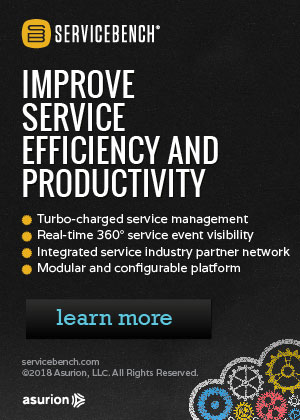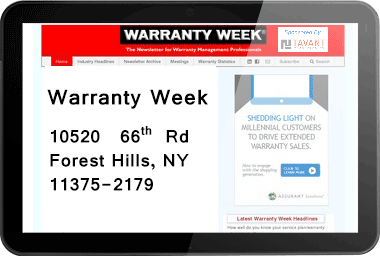September 12, 2006 |

|
ISSN 1550-9214 |
|
Editor's Note: This column by Greg Spraker of SAS Institute is the latest in a series of contributed editorial columns. Readers who are interested in authoring future contributed columns can click here to see the Guidelines for Editorial Submissions page. Warranty Financial Management:Part 1: Defining Warranty Expense Management.By Greg Spraker, SAS Institute Inc. Warranty financial management is a highly complex, misunderstood process. It also happens to be very profitable and is the primary location for insight into the customer experience. As with most processes, the profit and insight are always in the details. Today's article will explore the first of three progressively complex areas revolving around warranty financial management. The topics and dates are as follows:
Article 2: Optimizing Warranty Accruals (November 2006) Article 3: Faster Revenue Recognition for Extended Warranty Contracts (January 2007) On the outside, warranty financial management may appear to be a docile process that is easily understood and mastered. However, once one looks under the hood and sees all the direct and indirect support functions and organizations, one realizes that this is not a trivial issue. Prominent companies have always understood that in order to survive and thrive, they must link every customer experience data source, task and activity back into the organization. The faster the customer experience loop gets closed, the faster the organization can respond. This article will explore what is driving the need for warranty expense management, how to account for warranty expense and finally what are the contributing components of warranty expense. What Is Driving the Need for Warranty Expense Management?Warranty expense management is getting more visibility primarily due to two recent developments. Competitive market conditions may be the biggest incentive for some companies, for others it is strict government regulations that are the driving factor. Market ConditionsThe manufacturing market has been commoditized to the point that competing brand-labeled products are built under the same roof. This commoditization is forcing companies to differentiate themselves within the post-sale services organization. Best in class companies understand that in order to succeed in these competitive times, they must capture, understand and tie every customer interaction back into their business (or back into their business plan). Perhaps the most data rich and completely under-utilized, customer interaction revolves around warranty programs, specifically how to define warranty expenses. Government RegulationsAs if mounting pressure to survive were not enough to drive scrutiny into post-sale service, the government has issued several regulations that require companies to disclose details about data, expenses and accruals. Not only is warranty financial accounting something many companies must do for survival, but according to FASB Interpretation Number 45, they must report warranty accrual status on their financial statements as footnotes in tabular form within their SEC Form 10-Q and 10-K filings. Since 2003, some 800 publicly-traded companies have reported upon changes in their warranty reserve balance, complying with FIN 45. In addition to these FASB requirements, for several years now corporations within the automotive industry have been filing copies of their warranty data and expenses with the National Highway Transportation Safety Administration's new Early Warning System. The NHTSA uses warranty data patterns as justification for recalls. What does Warranty Expense Management Involve?One must understand the established guidelines that govern Warranty Expense Management. There are several guidelines, but we will review FIN 45 below. The Warranty Accounting TableThe FASB FIN 45 regulation requires companies to disclose the opening and closing balance of their warranty reserve funds, and to provide figures for the aggregate increases and decreases over the course of the year. Usually, the warranty accounting table includes six items:
Previously, only a handful of companies made any detailed warranty expense disclosures, and usually only in the form of the balances 1) and 6) in the list above. Others would reveal only the net change from 1) to 6), without disclosing the beginning and ending balances. Before 2003 most companies remained completely silent about their warranty expenses, providing external parties with no information at all. Now, however, thanks to the details included in the warranty tables, it is possible to externally track changes in warranty expense and spending rates with great accuracy. Warranty expense data is effecting stock prices as investors begin to understand the impact of high failure rates and repair expenses on profitability. The Impact of Warranty ExpensesThe net amount of warranty accruals made, as expressed in line 2) of the warranty table, is the amount set aside out of current product sales to fund the payment of forecasted warranty expenses for those products. Expressed in dollars, it is readily convertible into a percentage of sales by dividing accruals by total product sales or into percentage of cost of goods sold (COGS). The net amount of warranty expenses, as expressed in line 3), can similarly be converted into a percentage of sales figure. For this figure to be relevant, the calculation must use a dollar amount for total revenue minus non-warranted revenue streams such as service, finance, raw materials, and consumables. In a given industry, X% might be the prevailing rates for warranty accruals and claims. If a company is reporting X+3% percentages, it will have to answer to investors why it's so much higher than similar companies. For a company to have an answer, it first needs to understand all the components of its own warranty expenses, and second the components of other company's warranty tables. What is Warranty?In order to accurately account for warranty expense, one must first answer the "What is Warranty?" question, and then aggregate all the associated expenses. Since the definition of warranty has sometimes major and sometimes subtle differences within companies, having the "What is Warranty?" internal dialogue is a valuable exercise. Also, is warranty given away or is it sold? Some would suggest that in today's environment, warranty is being sold. As products are being commoditized in an effort to drive down expenses, it is not unusual for the differentiator to become after market services, specifically warranty and extended warranty. This "selling" of warranty is transforming warranty from something that provides a basic guarantee of product performance to a creation that is increasingly being seen as a "productized service." To define any product or service, one must understand and quantify the inputs and outputs. One approach would be to start at a high level and flowchart the expense inputs that are required to support each output function. Warranty ExpensesDefining warranty expense is not simple and requires knowledge of the entire warranty chain. This warranty chain may differ depending on several parameters, such as industry, organizational size, and business processes. We will provide sample inputs for warranty expenses that can be used a la carte for calculating warranty financial reports. The proposed approach is to divide warranty expenses into two components: 1) direct expenses and 2) indirect expenses. Once divided into two components, break these two components down to the contributing sources. Warranty Management Expense = Direct Expenses + Indirect Expenses The figures reported for warranty expenses are a net amount that includes both direct and indirect expenses. Please note that terms differ from organization to organization and may not apply directly to your business. 1) Direct Expenses are charges incurred while dealing directly with shipping, repairing/replacing or refurbishing a product. These expenses are the largest component: Direct Expenses = PC1 + PC2 + PC3
PC2 = Warranty Depot Repair/Replace/Refurbish Expenses PC3 = Field Services Repair/Replace/Refurbish Expenses Building a model to associate these areas with each product family is possible and desirable. This makes it easier to automate charges and changes into the following models: warranty expense, warranty reserve, revenue recognition and extended service contracts.
Storage/retention of Warranty Claim Employee Direct Labor charges (data processing) Contractor Labor charges (data processing) Direct Travel charges Direct Software/Equipment/Materials Overhead expenses from services business Training Expenses PC2 = Warranty Depot Repair/Replace/Refurbish
Contractor Labor charges Direct Travel charges Direct Parts/Materials expense for Repair/Replace/Refurbish Overhead expenses Training Expenses Test Equipment Shipping / Transportation Expenses PC3 = Field Services Repair/Replace/Refurbish
Contractor Labor charges Direct Travel charges Direct Parts/Materials expense for Repair/Replace/Refurbish Overhead expenses Training Expenses Test Equipment Shipping / Transportation Expenses 2) Indirect Expenses are charges incurred while supporting the management of the product. Indirect Expenses differ depending on the organization and may be difficult to collect which often requires assumptions and manual entry into ledger. Indirect Expenses = SC1 + SC2 + SC3 + SC4 + SC5 + SC6
SC2 = Warranty Related Call Center Activity SC3 = Warranty Related Inventory SC4 = Warranty Registration SC5 = Warranty Analysis Process Expenses SC6 = End of Life Disposal Expenses Most of these indirect expenses are entered as part of a bulk entry into the ledger and are difficult to automate. The typical approach for allocation of this type of expense is bottom-down - this means that a ratio of an expense (e.g. call center) is typically allocated to different expense groups (warranty, extended warranty, recall, technical inquires, etc). For instance, SC2 would typically be calculated manually (e.g. with an assumption that 25% of expenses are driven by warranty calls, then 0.25 x call center expense = SC2) however, it is possible to automate certain steps of the process.
Internal or 3rd party expenses for non-technical support (i.e. Usability questions, Prior Approval/Authorizations) Internal or 3rd party expenses for online (e-mail, whiteboard, IM, etc) product support during warranty period Internal or 3rd party expenses for web development & maintenance or active web support during warranty period Overhead expenses related to call or support centers (occupancy, corporate allocations, admin, etc)
3rd party expenses of acquiring and stocking of parts that are dedicated for warranty replacement Logistics expense for freight, warehousing distribution, parts management and associated overhead Reimbursement expenses to Retailer or Repair facility's for their expenses of acquiring and stocking of parts that are dedicated for warranty replacement Expenses related to carrying inventory for EOL support Management & write off of scrap/return and obsolescence
The expenses of support/administration staff The expenses of producing and administering registration documentation Those expenses, often internal (however some companies use external fulfillment companies), in obtaining, maintaining, validating, and reporting shipment information of serialized products. Use of external company may make this simpler.
Contractor Labor charges (data analysis) Direct Travel charges Direct Software/Equipment/Materials Overhead expenses from services business Training Expenses
RoHS Requirements: Expenses associated with compliance to Reduction of Hazardous Substance mandates such as lifetime buys, dual inventory pipelines, etc. Disclaimer: warranty accounting is principles-based and therefore the intention of this document is only to provide guidelines. However, the equation in this document may act as a best practice. Credits: The content of this article was developed in conjunction with members of the Warranty Benchmarking Team (part of the Institute of Warranty Chain Management), including Tom Washburn, Tom Bellinger, Kjell Hammarstrom, William Eliason, and Richard Howe. About the Author:Greg Spraker is a Service Intelligence Strategist at SAS Institute Inc. Greg has over 15 years experience in Reliability Engineering and Warranty Management in Telecommunications, Aerospace, Industrial Controls and Medical Devices. He consults with corporations that are seeking to build and optimize their Service Intelligence Center. He is a Certified Reliability Engineer and holds Bachelor and Masters degrees in Electrical Engineering. He can be reached at greg.spraker@sas.com. | |||||||||||||||||||||||||||||||||||||||||||||||||||||||||||||||||||||||||||||||||||||||||||
| |||||||||||||||||||||||||||||||||||||||||||||||||||||||||||||||||||||||||||||||||||||||||||







